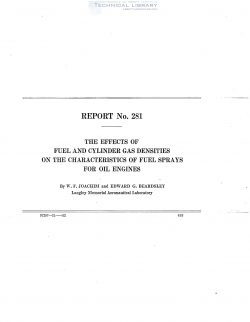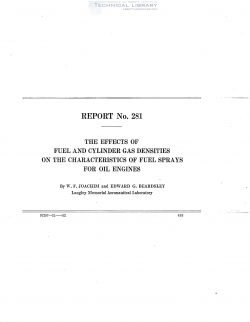naca-report-281

- Version
- 167 Downloads
- 771.97 KB File Size
- 1 File Count
- August 25, 2016 Create Date
- August 25, 2016 Last Updated
National Advisory Committee for Aeronautics, Report - The Effects of Fuel and Cylinder Gas Densities on the Characteristics of Fuel Sprays for Oil Engines

This investigation was conducted at the Langley Memorial Aeronautical Laboratory as a part
of a general research on fuel—injection engines for aircraft. The purpose of the incestigation was to
determine the ejects of fuel and cylinder gas densities upon several characteristics of fuel sprays for
oil engines.
The start, growth, and cut—off of single fuel sprays produced by automatic injection calves'were
recorded on photographic film. by means of special high—speed motion-picture apparatus. This
equipment, which has been described in previous reports, is capable of taking twenty-five consecutive
pictures of the moving spray at the rate of 4,000 per second.
The penetrations of the fuel sprays increased and the cone angles and relatice distributions
decreased un'th increase in the specific grazrity of the fuel. The density of the gas into which the fuel
sprays were injected controlled their penetration. This was the only characteristic of the chamber
gas that had a measurable eject upon the fuel sprays. Application of fuel—spray penetration data
to the case of an engine, in which the pressure is rising during injection, indicated that fuel sprays
may penetrate considerably farther than when injected into a- gas at a density equal to that of the gas
in an engine cylinder at top center.
The fuels used by internal-combustion engines operating on the Otto cycle are practically
limited thus far to the lighter and more volatile liquid hydrocarbons such as gasoline and kero-
sene. An outstanding advantage inherent in Diesel engines is that they may be operated on a
Wide variety of fuel oils. These oils range from those as light as kerosene to some so heavy that
they are usually heated for delivery to the engine. In general the light distillates give somewhat
better engine perfcrmance, but these fuels are more expensive.
| File | Action |
|---|---|
| naca-report-281 The Effects of Fuel and Cylinder Gas Densities on the Characteristics of Fuel Sprays for Oil Engines.pdf | Download |

Comment On This Post